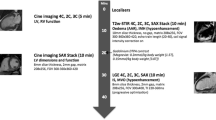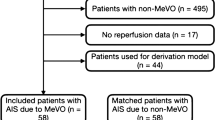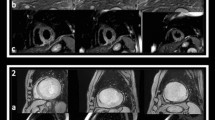Abstract
Objectives
Current methods for infarct size and microvascular obstruction (MVO) quantification by cardiac magnetic resonance (CMR) imaging rely on planimetry. This method is time-consuming. We sought to evaluate a direct assessment of MVO severity based on visual evaluation and to compare it to a reference method.
Methods
CMR was performed in 112 consecutive patients after reperfused myocardial infarction. MVO was estimated by direct visual assessment based on a three-grade severity scale (MVO 1, mild; MVO 2, moderate; MVO 3, severe) on late gadolinium-enhancement (LGE).
Results
MVO was present in 69 patients (61.6 %). Quantitative MVO extent significantly increased accordingly to visual MVO grading (p < 0.01). Correlation between visual grading and quantitative assessment was excellent (r = 0.92, IQR 0.88–0.95, p < 0.001). CMR inter- and intraobserver variability for visual MVO evaluation was low (κ = 0.93 and κ = 0.96, respectively), whereas quantitative MVO assessment suffered from moderate agreement (interobserver, bias = −0.81 ± 1.8 g LV; intraobserver, −0.83 ± 2.1 g LV). Visual evaluation was significantly faster than reference method (0.65 ± 0.37 vs. 10.2 ± 2.9 min, p < 0.0001).
Conclusions
MVO severity based on direct visual assessment on LGE images is feasible, rapid, reproducible and agrees very well with quantitative methods, with a very low inter- and intraobserver variability. Our approach could be used for routine evaluation in patients undergoing CMR after acute myocardial infarction.
Key Points
• Microvascular obstruction direct visual evaluation is feasible, rapid and highly reproducible.
• Microvascular obstruction direct visual evaluation correlates well with quantification by planimetry.
• Microvascular obstruction or no-reflow phenomenon is determined on late gadolinium-enhanced images.
• Cardiac MRI is useful for myocardial damage assessment after myocardial infarction.





Similar content being viewed by others
Abbreviations
- CMR:
-
cardiovascular magnetic resonance
- LGE:
-
late gadolinium enhancement
- LV:
-
left ventricle
- LVEDV:
-
left ventricle end-diastolic volume.
- LVEF:
-
left ventricle ejection fraction
- LVESV:
-
left ventricle end-systolic volume
- MVO:
-
microvascular obstruction
- PCI:
-
percutaneous coronary intervention
- STEMI:
-
ST elevation myocardial infarction
- SSFP:
-
steady-state free-precession
- TIMI:
-
thrombolysis in myocardial infarction
- TE:
-
echo time
- TR:
-
repetition time
References
Kloner RA, Ganote CE, Jennings RB (1974) The “no-reflow” phenomenon after temporary coronary occlusion in the dog. J Clin Invest 54(6):1496–1508
Nijveldt R, Hofman MBM, Hirsch A et al (2009) Assessment of microvascular obstruction and prediction of short-term remodeling after acute myocardial infarction: cardiac MR imaging study. Radiology 250(2):363–370
Ito H, Maruyama A, Iwakura K et al (1996) Clinical implications of the ‘no reflow’ phenomenon. A predictor of complications and left ventricular remodeling in reperfused anterior wall myocardial infarction. Circulation 93(2):223–228
de Waha S, Desch S, Eitel I et al (2010) Impact of early vs. late microvascular obstruction assessed by magnetic resonance imaging on long-term outcome after ST-elevation myocardial infarction: a comparison with traditional prognostic markers. Eur Heart J 31(21):2660–2668
Kim HW, Farzaneh-Far A, Kim RJ (2009) Cardiovascular magnetic resonance in patients with myocardial infarction: current and emerging applications. J Am Coll Cardiol 55(1):1–16
de Waha S, Desch S, Eitel I et al (2012) Relationship and prognostic value of microvascular obstruction and infarct size in ST-elevation myocardial infarction as visualized by magnetic resonance imaging. Clin Res Cardiol 101(6):487–495
Klug G, Mayr A, Schenk S et al (2012) Prognostic value at 5 years of microvascular obstruction after acute myocardial infarction assessed by cardiovascular magnetic resonance. J Cardiovasc Magn Reson 14:46
Bogaert J, Kalantzi M, Rademakers F, Dymarkowski S, Janssens S (2007) Determinants and impact of microvascular obstruction in successfully reperfused ST-segment elevation myocardial infarction. Assessment by magnetic resonance imaging. Eur Radiol 17(10):2572–2580
Thygesen K, Alpert JS, White HD et al (2007) Universal definition of myocardial infarction. Circulation 116(22):2634–2653
Task Force on Myocardial Revascularization of the European Society of Cardiology, the European Association for Cardio-Thoracic Society, European Association for Percutaneous Cardiovascular Interventions et al (2010) Guidelines on myocardial revascularization. Eur Heart J 31(20):2501–2555
Bland JM, Altman DG (1986) Statistical methods for assessing agreement between two methods of clinical measurement. Lancet 1(8476):307–310
Małek ŁA, Śpiewak M, Kłopotowski M, Miśko J, Rużyłło W, Witkowski A (2012) The size does not matter – the presence of microvascular obstruction but not its extent corresponds to larger infarct size in reperfused STEMI. Eur J Radiol 81(10):2839–2843
Mahrholdt H, Wagner A, Holly TA et al (2002) Reproducibility of chronic infarct size measurement by contrast-enhanced magnetic resonance imaging. Circulation 106(18):2322–2327
Thiele H, Kappl MJE, Conradi S, Niebauer J, Hambrecht R, Schuler G (2006) Reproducibility of chronic and acute infarct size measurement by delayed enhancement-magnetic resonance imaging. J Am Coll Cardiol 47(8):1641–1645
Rogers WJ, Frederick PD, Stoehr E et al (2008) Trends in presenting characteristics and hospital mortality among patients with ST elevation and non-ST elevation myocardial infarction in the National Registry of Myocardial Infarction from 1990 to 2006. Am Heart J 156(6):1026–1034
Kim RJ, Albert TS, Wible JH et al (2008) Performance of delayed-enhancement magnetic resonance imaging with gadoversetamide contrast for the detection and assessment of myocardial infarction: an international, multicenter, double-blinded, randomized trial. Circulation 117(5):629–637
Wu KC, Zerhouni EA, Judd RM et al (1998) Prognostic significance of microvascular obstruction by magnetic resonance imaging in patients with acute myocardial infarction. Circulation 97(8):765–772
Kim RJ, Chen EL, Lima JA, Judd RM (1996) Myocardial Gd-DTPA kinetics determine MRI contrast enhancement and reflect the extent and severity of myocardial injury after acute reperfused infarction. Circulation 94(12):3318–3326
Kramer CM, Rogers WJ, Theobald TM, Power TP, Petruolo S, Reichek N (1996) Remote noninfarcted region dysfunction soon after first anterior myocardial infarction. A magnetic resonance tagging study. Circulation 94(4):660–666
Engler RL, Schmid-Schonbein GW, Pavelec RS (1983) Leukocyte capillary plugging in myocardial ischemia and reperfusion in the dog. Am J Pathol 111(1):98–111
Wu KC (2012) CMR of microvascular obstruction and hemorrhage in myocardial infarction. J Cardiovasc Magn Reson 14:68
Rochitte CE, Lima JA, Bluemke DA et al (1998) Magnitude and time course of microvascular obstruction and tissue injury after acute myocardial infarction. Circulation 98(10):1006–1014
Bekkers SAM, Backes W, Kim R et al (2009) Detection and characteristics of microvascular obstruction in reperfused acute myocardial infarction using an optimized protocol for contrast-enhanced cardiovascular magnetic resonance imaging. Eur Radiol 19(12):2904–2912
Gerber BL, Rochitte CE, Melin JA et al (2000) Microvascular obstruction and left ventricular remodeling early after acute myocardial infarction. Circulation 101(23):2734–2741
Wu KC, Kim RJ, Bluemke DA et al (1998) Quantification and time course of microvascular obstruction by contrast-enhanced echocardiography and magnetic resonance imaging following acute myocardial infarction and reperfusion. J Am Coll Cardiol 32(6):1756–1764
Taylor AJ, Al-Saadi N, Abdel-Aty H, Schulz-Menger J, Messroghli DR, Friedrich MG (2004) Detection of acutely impaired microvascular reperfusion after infarct angioplasty with magnetic resonance imaging. Circulation 109(17):2080–2085
Lund GK, Stork A, Saeed M et al (2004) Acute myocardial infarction: evaluation with first-pass enhancement and delayed enhancement MR imaging compared with 201Tl SPECT imaging. Radiology 232(1):49–57
Judd RM, Lugo-Olivieri CH, Arai M et al (1995) Physiological basis of myocardial contrast enhancement in fast magnetic resonance images of 2-day-old reperfused canine infarcts. Circulation 92(7):1902–1910
Mather AN, Lockie T, Nagel E et al (2009) Appearance of microvascular obstruction on high resolution first-pass perfusion, early and late gadolinium enhancement CMR in patients with acute myocardial infarction. J Cardiovasc Magn Reson 11:33
Cochet A, Lalande A, Lorgis L et al (2010) Prognostic value of microvascular damage determined by cardiac magnetic resonance in non ST-segment elevation myocardial infarction: comparison between first-pass and late gadolinium-enhanced images. Invest Radiol 45(11):725–732
Nijveldt R, Beek AM, Hirsch A et al (2008) Functional recovery after acute myocardial infarction: comparison between angiography, electrocardiography, and cardiovascular magnetic resonance measures of microvascular injury. J Am Coll Cardiol 52(3):181–189
Sardella G, Mancone M, Bucciarelli-Ducci C et al (2009) Thrombus aspiration during primary percutaneous coronary intervention improves myocardial reperfusion and reduces infarct size: the EXPIRA (thrombectomy with export catheter in infarct-related artery during primary percutaneous coronary intervention) prospective, randomized trial. J Am Coll Cardiol 53(4):309–315
Sirol M, Gzara H, Logeart D et al (2014) Impact of intramyocardial hemorrage on LV remodeling after ST-elevation myocardial infarction. J Cardiovasc Magn Reson 16(Suppl 1):P103
van Kranenburg M, Magro M, Thiele H et al (2014) Prognostic value of microvascular obstruction and infarct size, as measured by CMR in STEMI patients. JACC Cardiovasc Imaging 7(9):930–939
Kandler D, Lucke C, Grothoff M et al (2014) The relation between hypointense core, microvascular obstruction and intramyocardial haemorrhage in acute reperfused myocardial infarction assessed by cardiac magnetic resonance imaging. Eur Radiol 24(12):3277–3288
Acknowledgment
The scientific guarantor of this publication is Marc Sirol, MD, PhD. The authors of this manuscript declare no relationships with any companies whose products or services may be related to the subject matter of the article. The authors state that this work was supported in part by the French Minister of Education and Research PHRC (Projet de Recherche Clinique) PREGICA-MRI # P081116 and has been registered in ClinicalTrials.gov (NCT01113268). Dr. Etienne Gayat, MD from the Clinical Epidemiology and Biostatistics Department kindly provided statistical advice for this manuscript in addition to Prof Eric Vicaut from Unité de Recherche Clinique Saint Louis - Lariboisière - Fernand Widal University Hospital.
No complex statistical methods were necessary for this paper. Institutional review board approval was obtained on 2010, February; #12233 (Comités de protection des personnes (CPP)). Written informed consent was obtained for each patient included in the study (PREGICA-MRI # P081116). No study subjects or cohorts have been previously. Methodology: prospective, observational, performed at multiple institutions.
Author information
Authors and Affiliations
Corresponding author
Rights and permissions
About this article
Cite this article
Sirol, M., Gzara, H., Gayat, E. et al. Comparison between visual grading and planimetric quantification of microvascular obstruction extent assessment in reperfused acute myocardial infarction. Eur Radiol 26, 2166–2175 (2016). https://doi.org/10.1007/s00330-015-4069-5
Received:
Revised:
Accepted:
Published:
Issue Date:
DOI: https://doi.org/10.1007/s00330-015-4069-5




